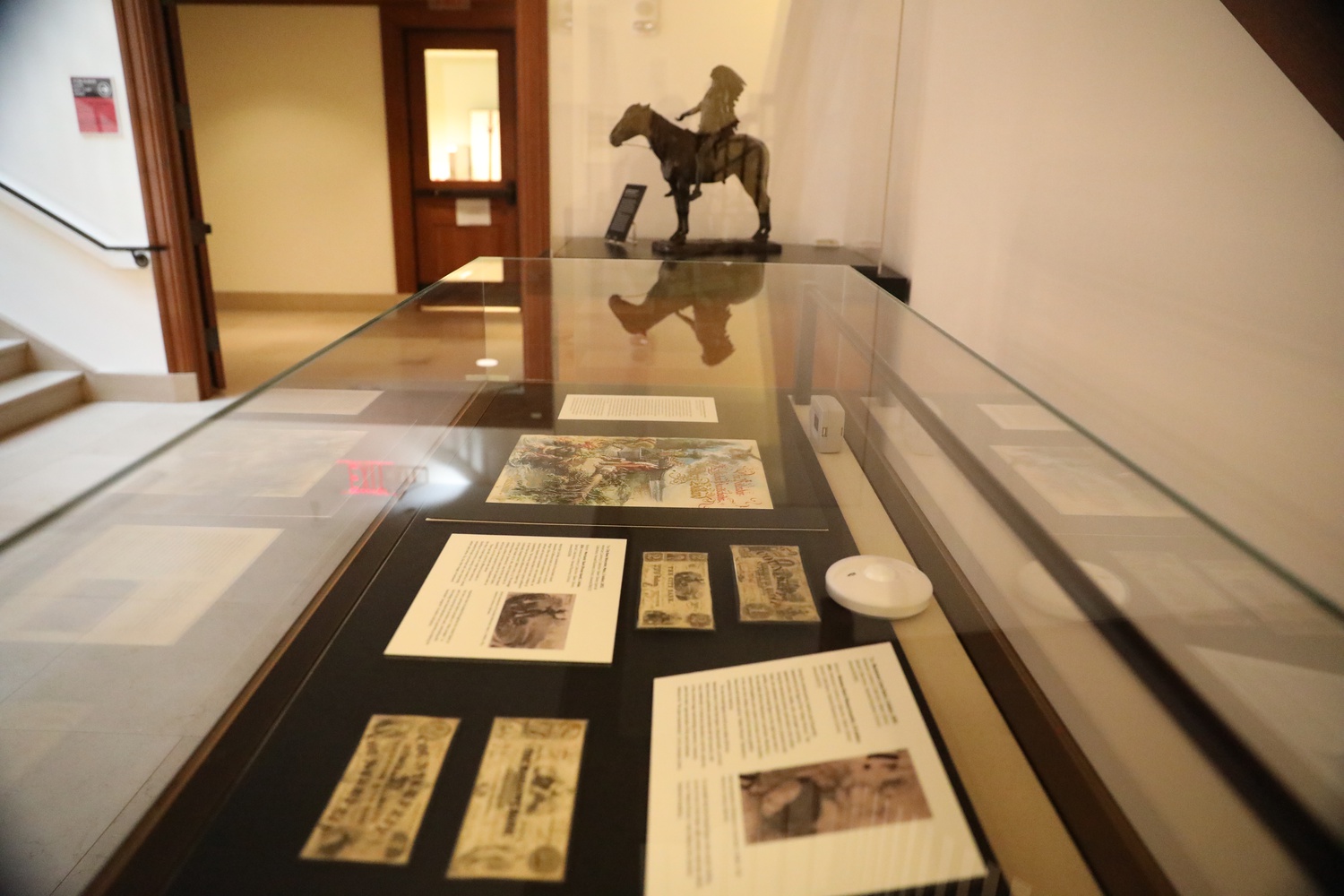
‘Seen and Unseen’: PhD Student Kabl Wilkerson Puts Native American Representation on Display
In a glass case on the Harvard Business School Baker Library’s mezzanine, a bronze statue of a Native American man in a feathered headdress sits on horseback, his head and arms raised towards the sky in a spiritual call.
This statue is a miniature version of Cyrus Dallin’s statue “Appeal to the Great Spirit”, which appears outside the Museum of Fine Arts Boston. Next to the work a plaque reads: “Dallin’s anachronistic, generalized, and romantic representation reveals much more about the artist and the prevailing Euro-American view of Native people as a ‘vanishing race’ than it does about the spiritual practices of Indigenous people living then or now.”
The Baker Library’s exhibit, “Seen and Unseen,” asks that viewers pass through a gallery of familiar misrepresentations and consider the history that they do not show. The objects — all over a hundred years old — display recognizable stereotypes, including those of the “noble savage” and the “vanishing race,” that persist into the present day.
“It’s not like Native people aren’t being seen,” Kabl Wilkerson, the exhibit’s curator explains.
“It’s drawing upon particular popular ideas, driven by stereotypes and a hefty amount of prejudice,” Wilkerson says of the exhibit “That’s really interesting because in the seeing, you are simultaneously unseeing. You are removing the ability for you to truly see who these folks are.”
Wilkerson, a second-year PhD student in Harvard’s History Department and a citizen of the Citizen Potawatomi Nation, curated the exhibit from the Baker Library archive through the Harvard Library’s Pforzheimer Fellowship. When they applied, the HBS Archives were seeking a researcher to identify and research objects for an exhibit on the representation of Indigenous peoples.
“The challenge was still there, of trying to understand the thematic thread running through all the collections,” says Wilkerson. “But somebody had to go through the gritty process of thumbing through cards and really looking at a lot of their digital collections.”
Wilkerson’s findings included many advertisements, currency, and trade cards packaged to attract customers who often collected them for scrapbooks. The artifacts are small, portable, and mundane. They passed between hands, decorated storefronts and albums, and all the while, quietly reinforced common stereotypes of “Indianness.”
For example, cards depicting each states’ founding revealed how foundational violence against Native people was in U.S. history. Their New Jersey card shows a group of settlers attacking unarmed Native Americans just below an image of George Washington, his horse rearing amid swirls of smoke and his fist triumphantly raised to the sky.
In depicting the history of each state, the trade cards are “supplementing a certain memory,” Wilkerson says. “Because what you’re seeing is not genocide. It’s necessary violence, to create the state of New Jersey or the state of New Mexico.”
In other artifacts, violence against Native peoples remains invisible, such as bills and currencies decorated with idealized versions of Westward expansion that leave out the era’s deadly Indian Wars and Indian Removal Act. Curating the exhibit also offered Wilkerson the opportunity to watch negotiations over history unfold across centuries to the present day, and themselves participate in those negotiations.
“How can I trace the kind of erasure and visible invisibility that exists?” Wilkerson says. “How can we have an understanding of the present where we have things like the Redskins juxtaposed with the Indian Child Welfare Act? These larger issues that are affecting real communities — not these imagined ones — fly under the radar and are totally subsumed by this larger American understanding of the national self.”
Pursuing this work as a Native scholar at the country’s oldest university presents its own complications. Last year, a University report revealed that Harvard holds the remains of almost 7,000 Native Americans in the Peabody Museum. News of the report broke shortly after Wilkerson began curation, and they still recall the experience vividly.

“I’m very well aware that in the Peabody’s collections there are many of my own relatives that exist from my community, that many other Native folks at Harvard also share from,” Wilkerson says. “That was actually one of the anxieties that I did have going into not just Baker, but into a Harvard archive in general. You don’t really know what might be there. And then of course, when I saw that it’s advertisements, that it’s currency — there was an immediate wash of relief that just flooded over me.”
For Wilkerson, however, their curation of the “Seen and Unseen” exhibit represented the creation of a new space within Harvard’s museum collections. The project was a chance for them, as well as the people in their community, to feel involved in the making of Harvard as a place — a process that is still ongoing.
“It’s rejecting a certain notion of invisibility that prioritizes certain narratives over others and just makes things more complicated,” Wilkerson says. “It’s nice, and it’s a privilege at that.”
— Magazine Writer Maeve T. Brennan can be reached at maeve.brennan@thecrimson.com.


